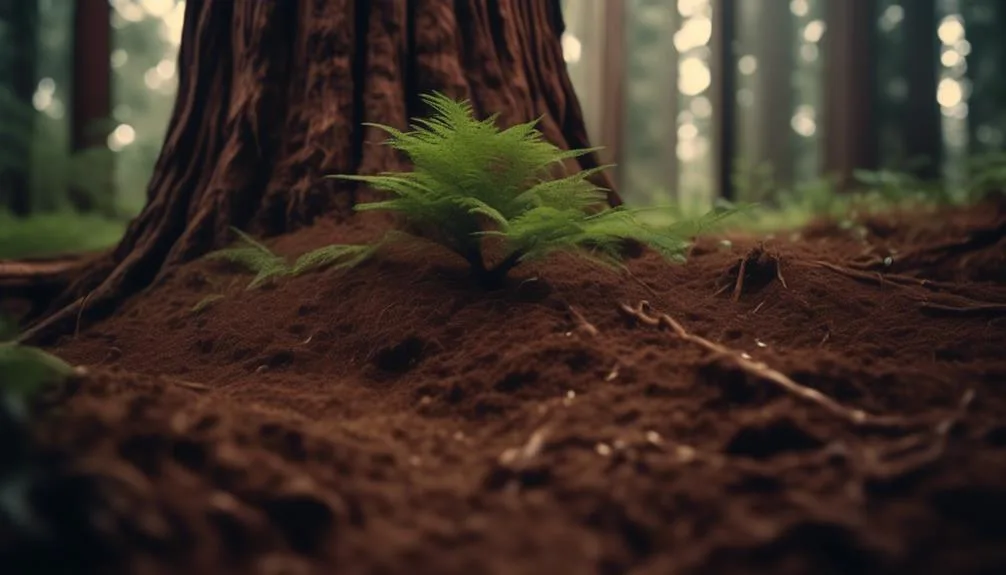The type of soil redwood trees grow in is crucial for their health and growth. Let's explore which soil types are best for these magnificent trees and how they impact their vitality.
Just like the saying, 'The best time to plant a tree was 20 years ago. The second best time is now.' applies to redwood trees as well. Understanding the soil that suits them best is essential for their well-being.
Sandy Loam Soil
Sandy loam soil provides an ideal balance of drainage and moisture retention for redwood trees, fostering healthy root development and overall growth. This soil composition is a perfect match for the water needs of redwoods, as it allows water to penetrate deep into the ground while also holding onto enough moisture for the trees' roots to access.
Redwood trees thrive in environments with consistent access to water, and sandy loam soil delivers just that. Its granular structure ensures that excess water doesn't linger around the roots, preventing waterlogging and potential root rot. At the same time, it retains enough moisture to sustain the trees during dry periods.
Choosing sandy loam soil for your redwood trees sets the stage for optimal water retention and root development, promoting their long-term health and vigor.
Well-Drained Soil
With well-drained soil, you can ensure that excess water doesn't linger around the roots of your redwood trees, preventing waterlogging and potential root rot while promoting healthy growth.
The ideal soil composition for redwood trees is one that allows for good drainage, such as sandy loam or loamy soil. Well-drained soil consists of a balanced mixture of sand, silt, and clay, which allows water to infiltrate and move through the soil freely.
This type of soil prevents water retention around the roots, helping to maintain the right moisture levels for the redwood trees. It also ensures that oxygen can reach the roots, enabling them to breathe and absorb nutrients effectively.
Acidic Soil
For optimal growth of your redwood trees, acidic soil provides the essential pH levels necessary for their health and vitality. Redwood trees thrive in acidic soil with a pH level between 5.0 and 6.5. The soil composition plays a crucial role in maintaining this acidity, as it influences the availability of nutrients for the trees.
Here are some important points to consider:
- pH Level: Aim for a pH level between 5.0 and 6.5 for optimal growth.
- Soil Composition: Acidic soil is typically made up of organic materials like pine needles and decomposed leaves.
- Nutrient Absorption: The acidic soil helps redwood trees absorb essential nutrients such as iron and manganese more efficiently.
- Moisture Retention: It aids in moisture retention, crucial for redwood trees during dry periods.
- Microbial Activity: Acidic soil promotes beneficial microbial activity, supporting the overall health of the redwood trees.
Acidic soil is fundamental for the successful cultivation of redwood trees, ensuring they receive the necessary nutrients and conditions for thriving growth.
Nutrient-Rich Soil
Transitioning from the importance of acidic soil for redwood trees, ensuring nutrient-rich soil is paramount for their sustained health and vigor.
Redwoods thrive in well-draining soil with high organic matter content. A balanced soil composition is key, encompassing a blend of sand, silt, and clay to promote proper water retention while preventing waterlogged conditions.
To maintain nutrient-rich soil, regular fertilizer application is essential. Organic fertilizers, such as compost or manure, contribute to the overall health of the soil and provide a slow-release of vital nutrients.
Additionally, a controlled-release commercial fertilizer can be used to ensure that the soil remains rich in essential elements. By carefully managing the soil composition and implementing a consistent fertilization schedule, you can create an optimal environment for redwood trees to flourish and thrive.
Moist Soil
To maintain optimal health for your redwood trees, it's important to ensure that the soil remains consistently moist, creating a supportive environment for their growth and vitality. When it comes to maintaining moist soil for your redwood trees, several key factors play a crucial role:
- Soil Drainage: Ensure proper drainage to prevent waterlogging, which can lead to root rot.
- Soil Composition: Use a well-balanced mix of organic matter and loamy soil to retain moisture without becoming waterlogged.
- Mulching: Apply a layer of organic mulch around the base of the trees to help retain moisture and regulate soil temperature.
- Watering Schedule: Develop a regular watering schedule to keep the soil consistently moist, especially during dry spells.
- Monitoring: Regularly check the moisture levels of the soil to ensure it remains consistently moist without becoming waterlogged.
Maintaining consistently moist soil is essential for the health and vitality of your redwood trees.
Conclusion
In crafting the right soil environment for redwood trees, sandy loam, well-drained, acidic, nutrient-rich, and moist soil types are essential. These conditions provide the perfect foundation for redwoods to thrive and reach their full potential.
By nurturing the soil, you can ensure the enduring grace and grandeur of these majestic trees in your landscape for years to come.

My interest in trees started when I first saw the giant sequoias in Yosemite.
I was a teenager then, and I remember thinking, “I need to learn more about this.”
That moment stuck with me.
A few years later, I went on to study forestry at Michigan Tech.
Since graduating, I’ve worked in a mix of hands-on tree care and community education.
I’ve spent over ten years helping people understand how to plant, maintain, and protect the trees in their neighborhoods.
I don’t see trees as just part of the landscape.
They are living things that make a real difference in our daily lives.
